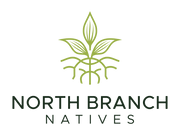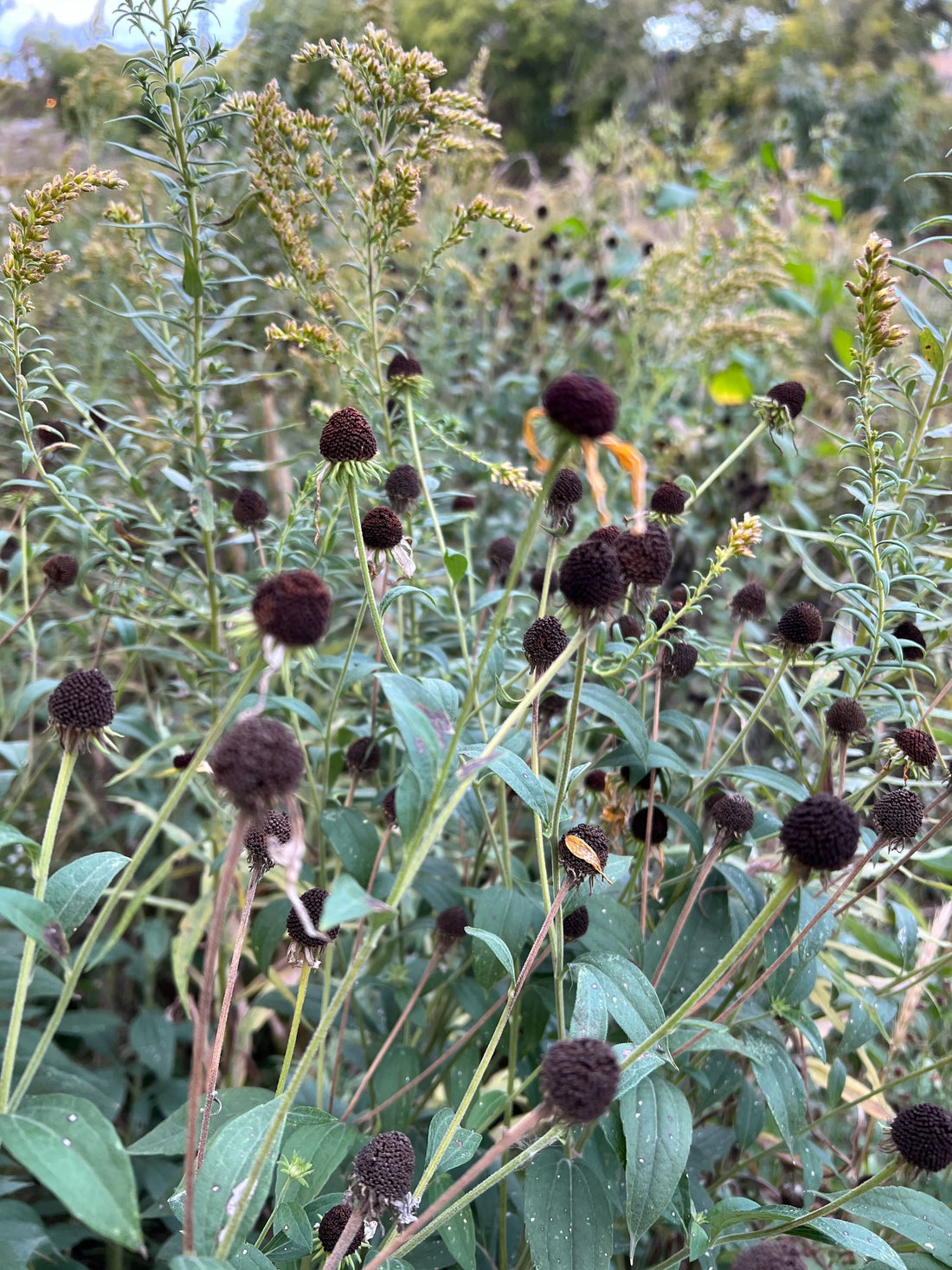When you intentionally plant a native garden with all-season interest in mind, you not only have blooms from spring to fall, but you also have seeds to save throughout the seasons.
Early in the season, wild columbine and penstemon bloom, and as they go to seed, Rudbeckia and Lobelia take their turn. As fall approaches, summer blooms turn into fall seeds, and asters and goldenrod step into the spotlight as some of the last to turn to seeds.
Native plants are deeply adapted to Illinois’s soils, climate, and seasons, which is especially evident when you take a look at how they reproduce. Everything, from how they develop and how they travel, to the very specific conditions they need to germinate are unique to the conditions we live in.
One of the best ways to get to know the native plants in your garden is to learn how each species reproduces. Seed saving is a practical way to do that. Blooms are beautiful, pollinators bring joy, but holding the future of a plant in your hand is something else entirely.

Pic: Penstemon seed heads
How to Harvest and Prepare Native Seeds
-
Identify your plant. Know what you’re collecting! (Pro tip: label everything. There’s a horticulture joke about asters—there are so many species that mystery asters get nicknamed ADA: Another Damn Aster. Don’t let that happen to you.)
-
Wait until seeds are dry. Ripe seeds usually rattle in their pods or pull away easily.
-
Collect into a paper bag or envelope. Shake, snip, or cut seed heads. Avoid using plastic, which can trap moisture. Only harvest a portion of the seeds and leave the rest. Remember, your garden is part of an ecosystem, and every part of a plant throughout the seasons plays a role in the overall balance of the system.
-
Clean your seeds. Remove petals, chaff, stems, or fluff (like milkweed’s silky threads).
-
Check stratification needs. Many Illinois natives require a cold, moist period to germinate, which mimics the natural conditions of fall rain, winter freezes, and spring thaws. Specific details of how much moisture or whether or not it would do better buried under some soil can make a difference, so do a little research.

Germination + Sowing
Gardening, even in a climate like Chicago's, can be a year-round experience. Turn those harvested seeds into native plants to expand or fill in your garden, or to share with neighbors and friends. Here are a few options:
-
Direct sow outdoors: Harvest seeds and sprinkle them directly in the spaces you’d like them to grow. This way, they’ll experience the natural freeze-thaw cycles without you having to intervene. Set it and forget it!
-
To direct sow into your garden(plan to do this in fall/close to winter):
-
Clear a space in your garden beds
to spread the seed. -
Loosen top layer of soil with a rake
or even your foot. -
Sprinkle seed and step down to
secure in place and to make sure
there is good soil contact.
-
-
-
Winter sowing: Repurpose milk jugs or cat litter containers to create mini greenhouses outdoors. There are Facebook groups and Reddit groups dedicated to this method, which is a favorite of many native plant-loving home gardeners. An excellent way to grow a lot of plants in a few months, to establish or expand a garden or to share with fellow gardeners.
-
Fridge stratification: To prepare your seeds for planting in the ground in the spring, you can simulate winter by chilling seeds with a damp medium in the fridge for the winter. This is where research comes in handy: some seeds need to be roughed up a bit to get the most out of this process.
Pro Tips for Successful Sowing + Germination:
-
Label your seeds and seedlings clearly. Do not skip this step!
-
Keep them moist. Set up irrigation or ask a friend to mist if you’re away.
-
Be patient! Many native seeds take months (and in some cases, a few years) to sprout.
Some easy winners you can start with:
- Aquilegia canadensis (columbine)
- Zizia aurea (golden Alexanders)
- Rudbeckia subtomentosa (sweet black-eyed Susan)
- Solidago flexicaulis (zig zag goldenrod)
Why We Love Seed-Saving
Every species has its own story. Milkweed seeds float on silky threads, echoing the monarchs they sustain. Columbine seeds are tiny, pepper-like, and spill from pods like glitter—ensuring even the most delicate-looking flowers hold their own. Over 35 species of birds have been known to feed on serviceberries, which they then use to fuel their flights, carrying the seeds in their bellies and depositing them along their journeys. Practicing seed saving is an opportunity to learn how native plants have adapted to thrive in your specific environment and to understand their role in the broader ecosystem.
Seed-saving is about connection to the plants and animals in our environment, but it can also be a great way of connecting to neighbors. You can offer up seeds and seedlings on your local community forum or even drop off labeled seed packets at a nearby little library.
Groups like the Avondale Gardening Alliance, a hyper-local network that hosts workshops, sales, and seed swaps, exist in many areas throught the Chicagoland area. Check your local library’s event calendar or ask at your local garden center if they know of any groups near you. Gardeners are often eager to share seeds, seedlings and knowledge, but it doesn’t hurt to show up to events with your own native seeds to share.
🌱 On A Personal Note (From Laura)
I’ve been known to get pretty sappy about gardening, and nothing makes me sappier than teaching my kids(6 and 9) how to garden. Teaching them how to notice, harvest, and grow from seeds has been one of my favorite parts. Watching them fill their tiny hands (and pockets) with seeds throughout the season is grounding and powerful.
I’m always reminded of Robin Wall Kimmerer’s words in Braiding Sweetgrass:
“This is really why I made my daughters learn to garden—so they would always have a mother to love them, long after I am gone.”
Holding a seed is like holding the whole world—and teaching my children to garden feels like letting the world hold them, too.


🌿 Ready to Grow Smarter?
Saving and sowing seeds is just the beginning. If you’re ready to design a garden that thrives year after year—and creates even more opportunities for seed-saving—book a Garden Consultation with North Branch Natives. We’ll help you:
-
Choose the right native plants for your space
-
Design a garden that works with Chicagoland’s soil + climate
-
Plan for year-round beauty and ecological benefit
-
Learn how to tend and grow with confidence
Dig Deeper:
-
How to Remove Turf – Step-by-step to make space for your native garden
-
Month-by-Month Gardening Guide – Free seasonal checklist for Chicagoland gardeners
-
Top Native Plants for Difficult Places – Resilient species that thrive where others struggle
And if you’re looking to connect with other gardeners, make sure you’re following us on Instagram and check out these Chicagoland resources:
-
Avondale Gardening Alliance – A hyper-local network of gardeners offering seed swaps, workshops, and plant sales right here in Chicago.
-
Chicago Botanic Garden – Classes, events, and their annual Seed Swap.
-
Illinois Native Plant Society – Dedicated to native plant conservation and education.
-
Forest Preserves of Cook County – Volunteer opportunities for seed collection and habitat restoration.

